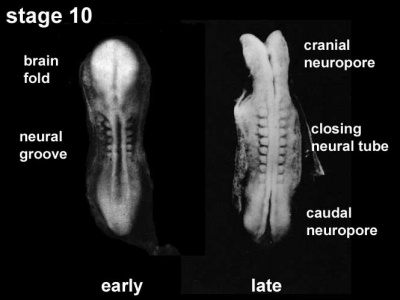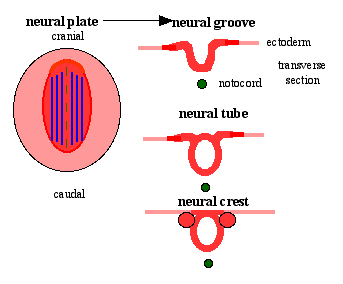2009 Lecture 6
Ectoderm Development
== Introduction ==
This lecture will cover the early development of the ectoderm layer of the trilaminar embryo. Note that we will be returning later to discuss neural (central nervous system; brain and spinal cord) and neural crest (peripheral nervous system; sensory and sympathetic ganglia). Epidermis (integumentary, skin contribution) development will be briefly mentioned due to its ectoderm origin, but will also be covered later in the current course.
Lecture Objectives
- Understanding of events during the third and fourth week of development
- Understanding the process of notochord formation
- Understanding the process of early neural development
- Brief understanding of neural crest formation
- Brief understanding of epidermis formation
- Understanding of the adult components derived from ectoderm
- Brief understanding of early neural abnormalities
Textbook References
- Human Embryology (3rd ed.) Chapter 5 p107-125
- The Developing Human: Clinically Oriented Embryology (6th ed.)
Other textbooks
- Moore and Persaud Chapter 18 p451-489
- Essentials of Human Embryology Larson Chapter 5 p69-79
- Before We Are Born (5th ed.) Moore and Persaud Chapter 19 p423-458
UNSW Embryology Links
- Ectoderm Slides Neural Lecture 5 2008 | Neural Lecture 2008 - 1 slide/page | Neural 2008 Slides - 4 slides/page | Neural Lecture 2008 Slides - 6 slides/page
- Ectoderm Movies Notochord | Notochord | Neural Plate | Neurulation | Secondary Neurulation
- Ectoderm Notes Neural Notes | Neural Crest Notes | Neural Abnormalities | Integumentary Development
Lecture Summary
The following text is extracted and modified from 2008 lecture slides and should be used as a "trigger" to remind you of key concepts.
- Early Neural Development (neuralation)
- Mesoderm - axial process (mesoderm), notochordal plate, notochord
- Ectoderm - neural plate, neural groove, neural tube, brain and spinal cord axes, neural tube layers, development of neurons and glia
- Neural crest - orogins
- Epidermis - ectoderm origins
Development Overview
Notochord
- forms initially as the Axial Process, a hollow tube which extends from the primitive pit , cranially to the oral membrane
- the axial process then allow transient communication between the amnion and the yolk sac through the neuroenteric canal.
- the axial process then merges with the Endodermal layer to form the Notochordal Plate.
- the notochordal plate then rises back into the Mesodermal layer as a solid column of cells which is the Notochord.
Ectoderm
- 2 parts
- midline neural plate
- columnar
- lateral surface ectoderm
- cuboidal
- sensory placodes
- epidermis of skin, hair, glands, ant. pituitary, teeth enamel
Neural Plate
- extends from buccopharyngeal membrane to primitive node
- forms above notochord and paraxial mesoderm
- neuroectodermal cells
- broad brain plate
- narrower spinal cord
- 3 components form: floor plate, neural plate, neural crest
Neural Determination- neuronal populations are specified before plate folds
- signals from notochord and mesoderm - secrete noggin, chordin,follistatin
- all factors bind BMP-4 an inhibitor of neuralation
- bone morphogenic protein acts through membrane receptor
- lateral inhibition generates at spinal cord level 3 strips of cells
- expression of delta inhibits nearby cells, which express notch receptor, from becoming neurons
- Delta-Notch inetraction- generates Neural strips
Neural Groove
- forms in the midline of the neural plate (day 18-19)
- either side of which are the neural folds which continues to deepen until about week 4
- neural folds begins to fuse, beginning at 4th somite level
Neural Tube
- the neural tube forms the brain and spinal cord
- fusion of neural groove extends rostrally and caudally
- begins at the level of 4th somite
- closes neural groove "zips up" in some species.
- humans appear to close at multiple points along the tube.
- leaves 2 openings at either end - Neuropores
- cranial neuropore closes before caudal
Secondary Neuralation
- caudal end of neural tube formed by secondary neuralation
- develops from primitive streak region
- solid cord canalized by extension of neural canal
- mesodermal caudal eminence
Neural Tube Defects (NTD)
- failure of neural tube closure
- severity dependent upon level, spina bifida anancephaly (More? Neural Abnormalities)
- found that supplementation of maternal diet with folate reduces incidence of NTDs
- A randomised controlled trial conducted by the Medical Research Council of the United Kingdom demonstrated a 72% reduction in risk of recurrence by periconceptional (ie before and after conception) folic acid supplementation (4mg daily).
- Women who have one infant with a neural tube defect have a significantly increased risk of recurrence (40-50 per thousand compared with 2 per thousand for all births)
Neural Crest
- a population of cells at the edge of the neural plate that lie dorsally when the neural tube fuses
- dorsal to the neural tube, as a pair of streaks
- pluripotential, forms many different types of cells
- cells migrate throughout the embryo
- studied by quail-chick chimeras
- transplanted quail cells have obvious nucleoli compared with chicken
Neural Crest Derivitives
- dorsal root ganglia
- autonomic ganglia
- adrenal medulla
- drg sheath cells, glia
- pia-arachnoid sheath
- skin melanocytes
- connective tissue of cardiac outflow
- thyroid parafollicular cells
- craniofacial skeleton
- teeth odontoblasts
Early Brain Structure
Primary Vesicles
- rostral neural tube forms 3 primary brain vesicles (week 4)
- 3 primary vesicles: prosencephalon (forebrain), mesencephalon (midbrain), rhombencephalon (hindbrain)
Secondary Vesicles
From the 3 primary vesicles developing to form 5 secondary vesicles
- prosencephalon- telencephalon (endbrain, forms cerebral hemispheres), diencephalon (betweenbrain, forms optic outgrowth)
- mesencephalon
- rhombencephalon- metencephalon (behindbrain), myelencephalon (medullabrain)
Ventricles
MH - this will be covered in detail in later neural development
- cavity within tube will form the contiguious space of the ventricules of the brain and central canal of spinal cord
- this space is filled initially with amniotic fluid, later with CerebroSpinal Fluid (CSF)
- CSF is secreted by a modified vascular structure, the chorioid plexus, lying within the ventricles
- (More? [Notes Chorioid Plexus)
Brain Flexures
Rapid growth folds the neural tube forming 3 brain flexures
- cervical flexure - between brain stem and spinal cord
- midbrain flexure - pushes mesencephalon upwards
- pontine flexure - generates 4th ventricle
Neural Layers
- neural stem cells lie in the layer closest to the ventricular space, the ventricular layer
- this layer generates both neuroblasts and glioblasts
- neuroblasts arise first and migrate along radial gial
- their migration stops at cortical plate
Spinal Cord Axes
Identified by experimental manipulation of interactions.
- Initial experiments looked at how isolated tissues may influence the development of the spinal cord.
- Repositionining of specific tissues both in vivo and in vitro
- specific markers of or alteration of differentiation. Notocord Induction
Ventral Axis
- Sonic Hedgehog - notochord secretes sonic hedgehog
- Gene expression studies (ISH) showed shh gene expression occured in a subset of inducing tissues
- has a patterning role elsewhere (limb, sclerotome, lung)
- 2 signaling activities acting (locally and at a distance) Ventral- Sonic Hedgehog
- Binds to cell surface receptor patched
- without shh, patched (Ptc) binds smoothened (Smo)
- with shh shh-Ptc releases Smo activating G protein pathway Gene Diseases
- shh Human mutation- holoprosencephaly 3
- characteristic faces of the severe form of HPE which included a single fused eye (cyclopia) and a nose-like structure (proboscis) above the eye
- Downstream targets of Sonic hedgehog signalling:
- transcription factors like Gli3 (responsible for Greigs polycephalosyndactyly in humans)
- d Hoxd13 (responsible for polysyndactyly)
Dorsal Axis
- Dorsalin - ectoderm secretes a growth factor shown to controls patterning in embryonic mesoderm (frog)
- Transforming Growth factor beta, (TGF b), related factors BMP-2, BMP-4, BMP-7, radar (flies related protein determines dorsoventral)
- homology search of vertebrate library identified protein of same family.
- dorsalin-1 (dsl-1) (Basler, Cell 73, p687, 1993) Dorsalin-1
- From overlying ectoderm
- Naming comes from the obvious reason that it promotes the differentiation of neural crest cells.
- Also signal for dorsal signal of neural tube.
- Inhibits the differentiation of motoneurons.
- Implication is that dsl-1 and shh act antagonistically, or competitively to establish d-v axis of neural tube.
Rostro-Caudal Axis
- Brain rostro-caudal axis is generated by differential expression of Hox genes (transcriptional activators)
- corresponding to genetic order on chromosome. (Wilkinson, Nature, 341, p405, 1989) Hox Genes
- Stands for Homeobox domain Genes
- A family of transcription factors
- Discovered in flies and conserved between all species. [../OtherEmb/fly.htm#antennapedia antennapedia]
- Expressed in sequence along the embryo rostro-caudal axis.
- Regulate many other aspects of development.
- 180aa region binds DNA and regulate gene expression
- large family of genes organized and expressed in sequence on the chromosome
- Nkx-2.2 first detected at 1 somite stage
- Lim hox gene expressed at spinal cord level
Ectodermal Placodes
- Specialized ectodermal "patches" in the head region
- Contribute sensory structures - otic placode (otocyst), nasal placode, lens placode
- Contribute teeth
Neural tube and Genes: neural specification- Notch/Delta, patched receptor. Border- fibroblast growth factor (fgf), BMP (BMP4, msx1) Rostral border- Dlx5 Neural tube patterning
- segmented along its length- Hox/Lim gene expression
- ventral identity- sonic hedgehog, BMP7/chordin interaction
- dorsal identity- dorsalin
Human Neuralation - Early Stages
The stages below refer to specific Carneigie stages of development.
- stage 8 (about 18 postovulatory days) neural groove and folds are first seen
- stage 9 the three main divisions of the brain, which are not cerebral vesicles, can be distinguished while the neural groove is still completely open.
- stage 10 (two days later) neural folds begin to fuse near the junction between brain and spinal cord, when neural crest cells are arising mainly from the neural ectoderm
- stage 11 (about 24 days) the rostral (or cephalic) neuropore closes within a few hours; closure is bidirectional, it takes place from the dorsal and terminal lips and may occur in several areas simultaneously. The two lips, however, behave differently.
- stage 12 (about 26 days) The caudal neuropore takes a day to close
- the level of final closure is approximately at future somitic pair 31
- corresponds to the level of sacral vertebra 2
- stage 13 (4 weeks) the neural tube is normally completely closed
Secondary neurulation begins at stage 12
- is the differentiation of the caudal part of the neural tube from the caudal eminence (or end-bud) without the intermediate phase of a neural plate.
(Stage text modified from: Neurulation in the normal human embryo. O'Rahilly R, Muller F Ciba Found Symp 1994;181:70-82)
Critical Periods of Human Development to Teratogens
UNSW Embryology Links
Internet Links
Embryo Images Early Cell Populations and Establishment of Body Form | Nervous System Development
Society for Neuroscience http://web.sfn.org/content/Publications/BrainFacts/index.html Brain Facts
Anatomy of the Human Body The Neural Groove and Tube
Glossary Links
A | B | C | D | E | F | G | H | I | J | K | L | M | N | O | P | Q | R | S | T | U | V | W | X | Y | Z
Next Lecture
Lab 3 | Lecture 7 | Course Timetable
- Dr Mark Hill 2009 UNSW CRICOS Provider Code No. 00098G

